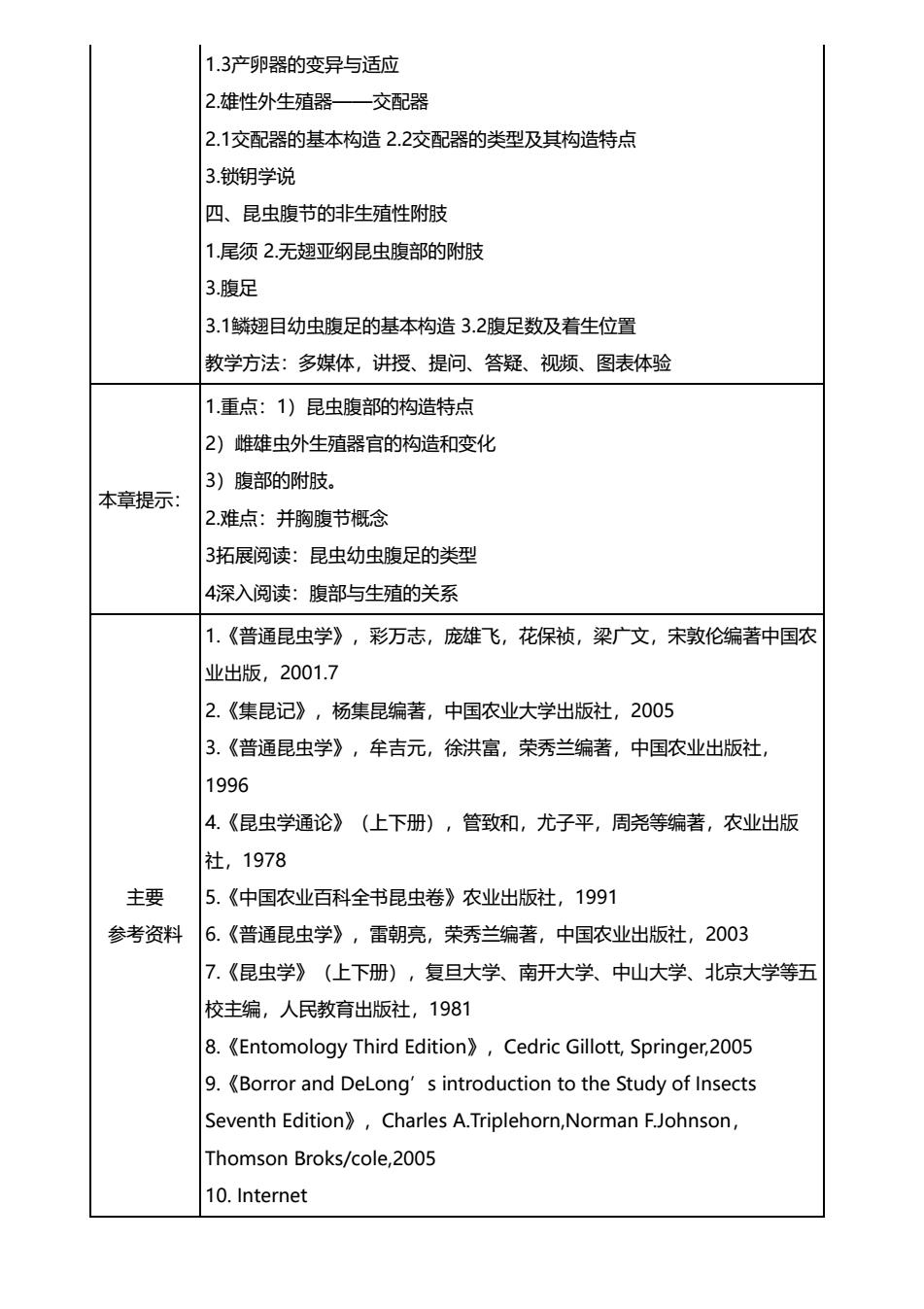
1.3产卵器的变异与适应 2雄性外生殖器—交配器 2.1交配器的基本构造2.2交配器的类型及其构造特点 3锁钥学说 四、昆虫腹节的非生殖性附肢 1尾须2.无翅亚纲昆虫腹部的附肢 3腹足 3.1鳞翅目幼虫腹足的基本构造3.2腹足数及着生位置 教学方法:多媒体,讲授、提问、答疑、视频、图表体验 1重点:1)昆虫腹部的构造特点 2)雌雄虫外生殖器官的构造和变化 3)腹部的附肢。 本章提示: 2难点:并胸腹节概念 3拓展阅读:昆虫幼虫腹足的类型 4深入阅读:腹部与生殖的关系 1.《普通昆虫学》,彩万志,庞雄飞,花保祯,梁广文,宋敦伦编著中国农 业出版,2001.7 2.《集昆记》,杨集昆编著,中国农业大学出版社,2005 3.《普通昆虫学》,牟吉元,徐洪富,荣秀兰编著,中国农业出版社, 1996 4.《昆虫学通论》(上下册),管致和,尤子平,周尧等编著,农业出版 社,1978 主要 5.《中国农业百科全书昆虫卷》农业出版社,1991 参考资料 6.《普通昆虫学》,雷朝亮,荣秀兰编著,中国农业出版社,2003 7.《昆虫学》(上下册),复旦大学、南开大学、中山大学、北京大学等五 校主编,人民教育出版社,1981 8.Entomology Third Edition),Cedric Gillott,Springer,2005 9.Borror and DeLong's introduction to the Study of Insects Seventh Edition),Charles A.Triplehorn,Norman F.Johnson, Thomson Broks/cole,2005 10.Internet
1.3产卵器的变异与适应 2.雄性外生殖器——交配器 2.1交配器的基本构造 2.2交配器的类型及其构造特点 3.锁钥学说 四、昆虫腹节的非生殖性附肢 1.尾须 2.无翅亚纲昆虫腹部的附肢 3.腹足 3.1鳞翅目幼虫腹足的基本构造 3.2腹足数及着生位置 教学方法:多媒体,讲授、提问、答疑、视频、图表体验 本章提示: 1.重点:1)昆虫腹部的构造特点 2)雌雄虫外生殖器官的构造和变化 3)腹部的附肢。 2.难点:并胸腹节概念 3拓展阅读:昆虫幼虫腹足的类型 4深入阅读:腹部与生殖的关系 主要 参考资料 1.《普通昆虫学》,彩万志,庞雄飞,花保祯,梁广文,宋敦伦编著中国农 业出版,2001.7 2.《集昆记》,杨集昆编著,中国农业大学出版社,2005 3.《普通昆虫学》,牟吉元,徐洪富,荣秀兰编著,中国农业出版社, 1996 4.《昆虫学通论》(上下册),管致和,尤子平,周尧等编著,农业出版 社,1978 5.《中国农业百科全书昆虫卷》农业出版社,1991 6.《普通昆虫学》,雷朝亮,荣秀兰编著,中国农业出版社,2003 7.《昆虫学》(上下册),复旦大学、南开大学、中山大学、北京大学等五 校主编,人民教育出版社,1981 8.《Entomology Third Edition》,Cedric Gillott, Springer,2005 9.《Borror and DeLong’s introduction to the Study of Insects Seventh Edition》,Charles A.Triplehorn,Norman F.Johnson, Thomson Broks/cole,2005 10. Internet
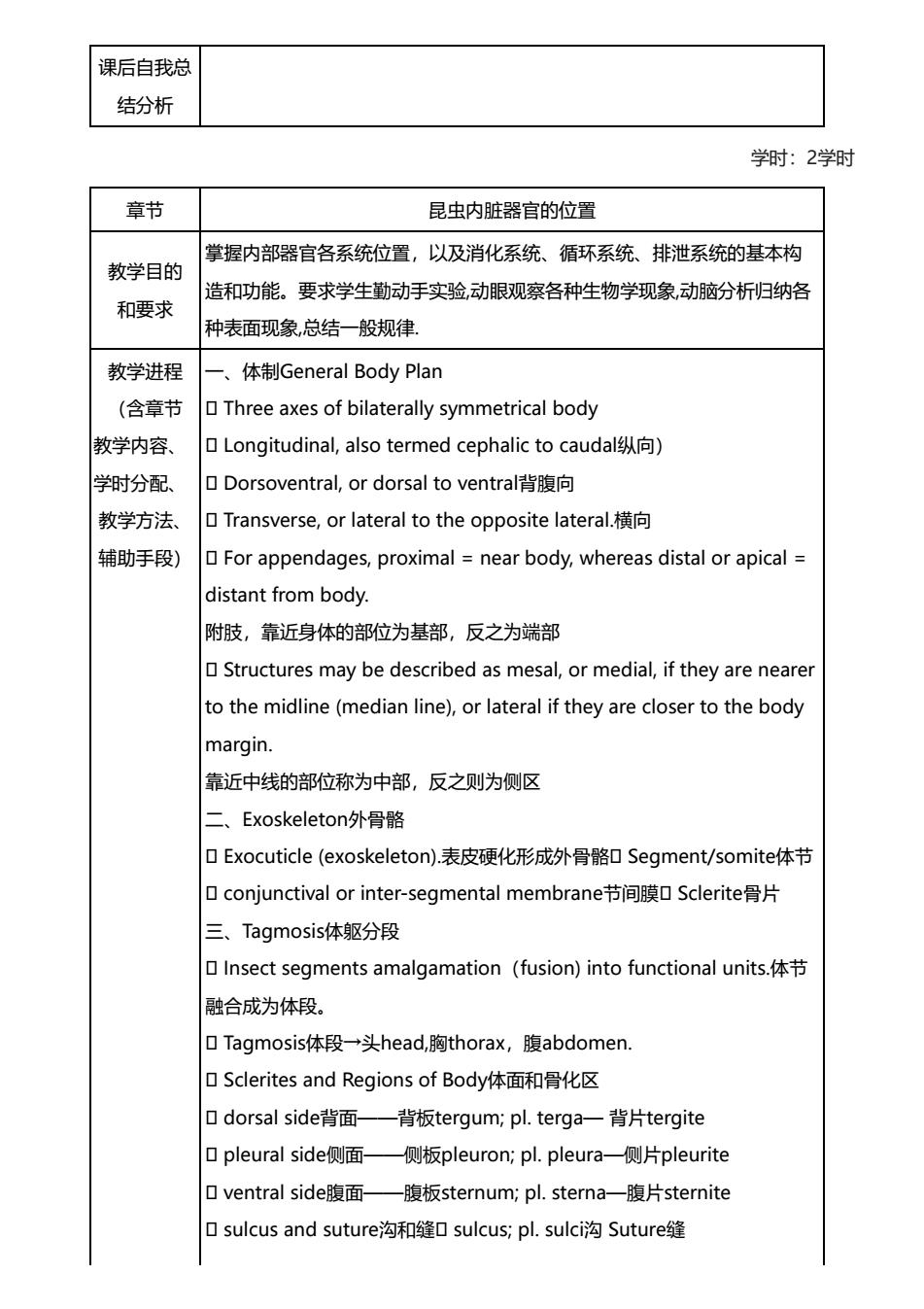
课后自我总 结分析 学时:2学时 章节 昆虫内脏器官的位置 掌握内部器官各系统位置,以及消化系统、循环系统、排泄系统的基本构 教学目的 造和功能。要求学生勤动手实验,动眼观察各种生物学现象,动脑分析归纳各 和要求 种表面现象,总结一般规律 教学进程 一、 体制General Body Plan (含章节 Three axes of bilaterally symmetrical body 教学内容、 Longitudinal,also termed cephalic to caudal) 学时分配、 Dorsoventral,or dorsal to ventral背腹向 教学方法、 Transverse,or lateral to the opposite lateral. 辅助手段) For appendages,proximal near body,whereas distal or apical distant from body. 附肢,靠近身体的部位为基部,反之为端部 Structures may be described as mesal,or medial,if they are nearer to the midline(median line),or lateral if they are closer to the body margin. 靠近中线的部位称为中部,反之则为侧区 二、Exoskeleton外骨骼 Exocuticle(exoskeleton),表皮硬化形成外骨骼Segment/somitef体节 conjunctival or inter--segmental membrane节间膜·Sclerite骨片 三、Tagmosis体躯分段 Insect segments amalgamation (fusion)into functional units. 融合成为体段。 Tagmosis体段一头head,胸thorax,腹abdomen.. Sclerites and Regions of Body体面和骨化区 dorsal side背面一一背板tergum;pl.terga-一背片tergite pleural side侧面一侧板pleuron;pl.pleura-一侧片pleurite ventral side腹面一腹板sternum;pl.sterna-一腹片sternite sulcus and suture沟和缝sulcus;pl.sulci沟Suture缝
课后自我总 结分析 学时:2学时 章节 昆虫内脏器官的位置 教学目的 和要求 掌握内部器官各系统位置,以及消化系统、循环系统、排泄系统的基本构 造和功能。要求学生勤动手实验,动眼观察各种生物学现象,动脑分析归纳各 种表面现象,总结一般规律. 教学进程 (含章节 教学内容、 学时分配、 教学方法、 辅助手段) 一、体制General Body Plan Three axes of bilaterally symmetrical body Longitudinal, also termed cephalic to caudal纵向) Dorsoventral, or dorsal to ventral背腹向 Transverse, or lateral to the opposite lateral.横向 For appendages, proximal = near body, whereas distal or apical = distant from body. 附肢,靠近身体的部位为基部,反之为端部 Structures may be described as mesal, or medial, if they are nearer to the midline (median line), or lateral if they are closer to the body margin. 靠近中线的部位称为中部,反之则为侧区 二、Exoskeleton外骨骼 Exocuticle (exoskeleton).表皮硬化形成外骨骼 Segment/somite体节 conjunctival or inter-segmental membrane节间膜 Sclerite骨片 三、Tagmosis体躯分段 Insect segments amalgamation(fusion) into functional units.体节 融合成为体段。 Tagmosis体段→头head,胸thorax,腹abdomen. Sclerites and Regions of Body体面和骨化区 dorsal side背面——背板tergum; pl. terga— 背片tergite pleural side侧面——侧板pleuron; pl. pleura—侧片pleurite ventral side腹面——腹板sternum; pl. sterna—腹片sternite sulcus and suture沟和缝 sulcus; pl. sulci沟 Suture缝
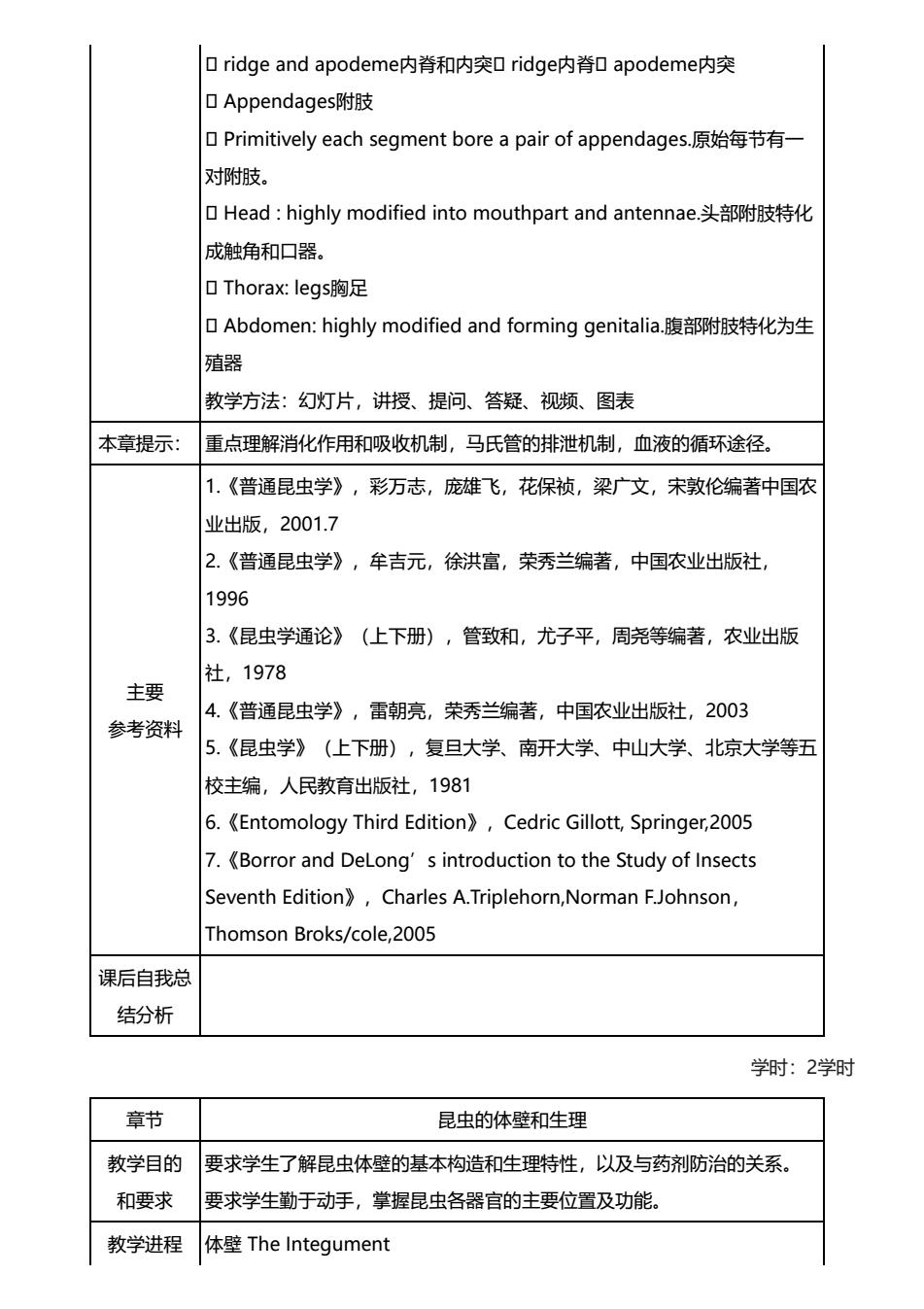
·ridge and apodemep内脊和内突·ridger内脊apodeme内突 ·Appendages附肢 Primitively each segment bore a pair of appendages..原始每节有一 对附肢。 OHead:highly modified into mouthpart and antennae.头部附肢特化 成触角和口器。 ·Thorax:legs胸足 Abdomen:highly modified and forming genitalia.腹部附肢特化为生 殖器 教学方法:幻灯片,讲授、提问、答疑、视频、图表 本章提示: 重点理解消化作用和吸收机制,马氏管的排泄机制,血液的循环途径。 1. 《普通昆虫学》,彩万志,庞雄飞,花保祯,梁广文,宋敦伦编著中国农 业出版,2001.7 2.《普通昆虫学》,牟吉元,徐洪富,荣秀兰编著,中国农业出版社, 1996 3.《昆虫学通论》 (上下册),管致和,尤子平,周尧等编著,农业出版 社,1978 主要 4.《普通昆虫学》,雷朝亮,荣秀兰编著,中国农业出版社,2003 参考资料 5.《昆虫学》(上下册),复旦大学、南开大学、中山大学、北京大学等五 校主编,人民教育出版社,1981 6.Entomology Third Edition),Cedric Gillott,Springer,2005 7.Borror and DeLong's introduction to the Study of Insects Seventh Edition),Charles A.Triplehorn,Norman F.Johnson, Thomson Broks/cole,2005 课后自我总 结分析 学时:2学时 章节 昆虫的体壁和生理 教学目的 要求学生了解昆虫体壁的基本构造和生理特性,以及与药剂防治的关系。 和要求 要求学生勤于动手,掌握昆虫各器官的主要位置及功能。 教学进程 体壁The Integument
ridge and apodeme内脊和内突 ridge内脊 apodeme内突 Appendages附肢 Primitively each segment bore a pair of appendages.原始每节有一 对附肢。 Head : highly modified into mouthpart and antennae.头部附肢特化 成触角和口器。 Thorax: legs胸足 Abdomen: highly modified and forming genitalia.腹部附肢特化为生 殖器 教学方法:幻灯片,讲授、提问、答疑、视频、图表 本章提示: 重点理解消化作用和吸收机制,马氏管的排泄机制,血液的循环途径。 主要 参考资料 1.《普通昆虫学》,彩万志,庞雄飞,花保祯,梁广文,宋敦伦编著中国农 业出版,2001.7 2.《普通昆虫学》,牟吉元,徐洪富,荣秀兰编著,中国农业出版社, 1996 3.《昆虫学通论》(上下册),管致和,尤子平,周尧等编著,农业出版 社,1978 4.《普通昆虫学》,雷朝亮,荣秀兰编著,中国农业出版社,2003 5.《昆虫学》(上下册),复旦大学、南开大学、中山大学、北京大学等五 校主编,人民教育出版社,1981 6.《Entomology Third Edition》,Cedric Gillott, Springer,2005 7.《Borror and DeLong’s introduction to the Study of Insects Seventh Edition》,Charles A.Triplehorn,Norman F.Johnson, Thomson Broks/cole,2005 课后自我总 结分析 学时:2学时 章节 昆虫的体壁和生理 教学目的 和要求 要求学生了解昆虫体壁的基本构造和生理特性,以及与药剂防治的关系。 要求学生勤于动手,掌握昆虫各器官的主要位置及功能。 教学进程 体壁 The Integument
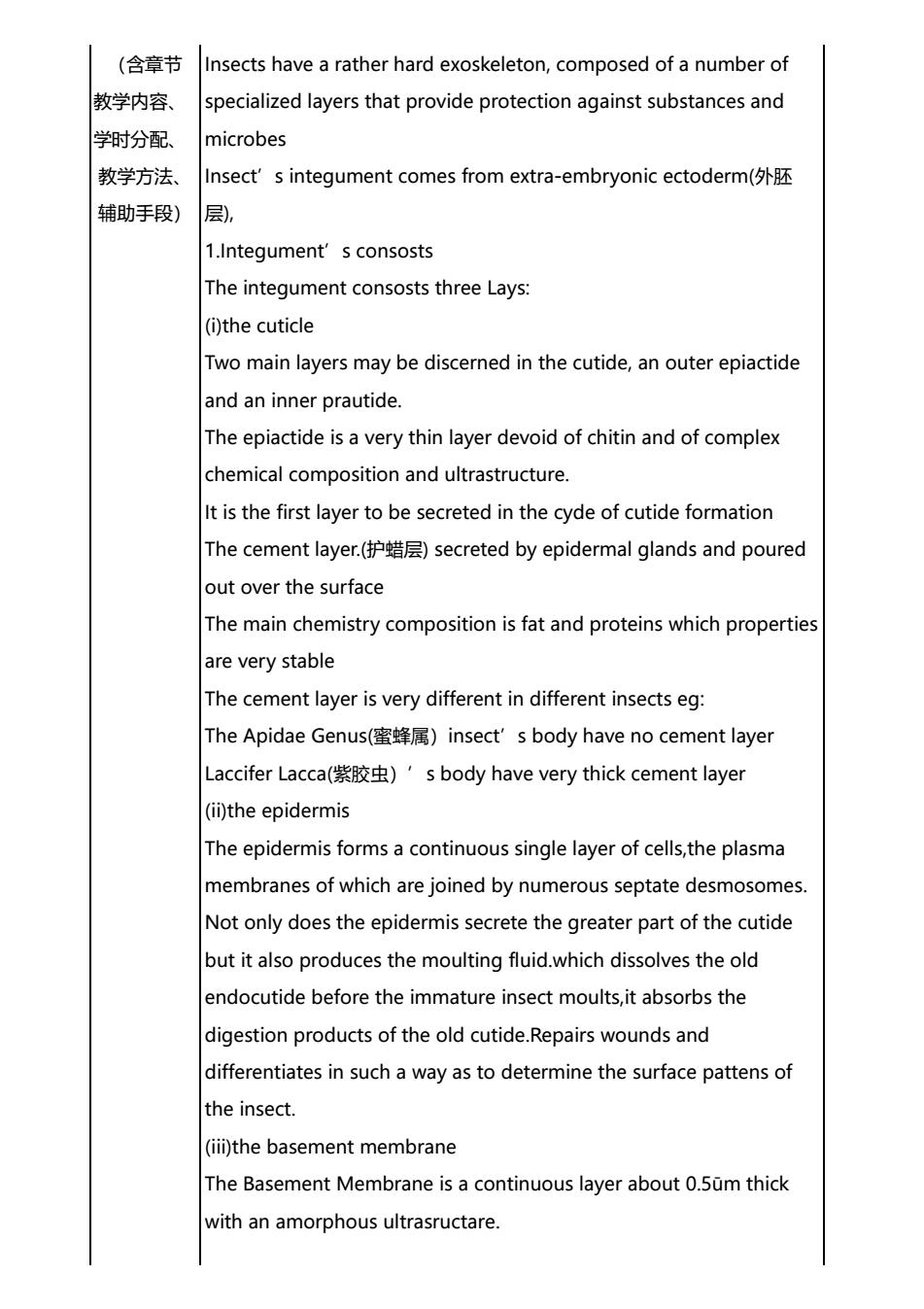
(含章节 Insects have a rather hard exoskeleton,composed of a number of 教学内容、 specialized layers that provide protection against substances and 学时分配、 microbes 教学方法、 Insect's integument comes from extra-embryonic ectoderm( 辅助手段) 层), 1.Integument's consosts The integument consosts three Lays: (i)the cuticle Two main layers may be discerned in the cutide,an outer epiactide and an inner prautide. The epiactide is a very thin layer devoid of chitin and of complex chemical composition and ultrastructure. It is the first layer to be secreted in the cyde of cutide formation The cement layer..(护蜡层)secreted by epidermal glands and poured out over the surface The main chemistry composition is fat and proteins which properties are very stable The cement layer is very different in different insects eg: The Apidae Genus(蜜蜂属)insect's body have no cement layer Laccifer Lacca(紫胶虫)'s body have very thick cement layer (ii)the epidermis The epidermis forms a continuous single layer of cells,the plasma membranes of which are joined by numerous septate desmosomes. Not only does the epidermis secrete the greater part of the cutide but it also produces the moulting fluid.which dissolves the old endocutide before the immature insect moults,it absorbs the digestion products of the old cutide.Repairs wounds and differentiates in such a way as to determine the surface pattens of the insect. (iii)the basement membrane The Basement Membrane is a continuous layer about 0.5um thick with an amorphous ultrasructare
(含章节 教学内容、 学时分配、 教学方法、 辅助手段) Insects have a rather hard exoskeleton, composed of a number of specialized layers that provide protection against substances and microbes Insect’s integument comes from extra-embryonic ectoderm(外胚 层), 1.Integument’s consosts The integument consosts three Lays: (i)the cuticle Two main layers may be discerned in the cutide, an outer epiactide and an inner prautide. The epiactide is a very thin layer devoid of chitin and of complex chemical composition and ultrastructure. It is the first layer to be secreted in the cyde of cutide formation The cement layer.(护蜡层) secreted by epidermal glands and poured out over the surface The main chemistry composition is fat and proteins which properties are very stable The cement layer is very different in different insects eg: The Apidae Genus(蜜蜂属)insect’s body have no cement layer Laccifer Lacca(紫胶虫)’s body have very thick cement layer (ii)the epidermis The epidermis forms a continuous single layer of cells,the plasma membranes of which are joined by numerous septate desmosomes. Not only does the epidermis secrete the greater part of the cutide but it also produces the moulting fluid.which dissolves the old endocutide before the immature insect moults,it absorbs the digestion products of the old cutide.Repairs wounds and differentiates in such a way as to determine the surface pattens of the insect. (iii)the basement membrane The Basement Membrane is a continuous layer about 0.5ūm thick with an amorphous ultrasructare
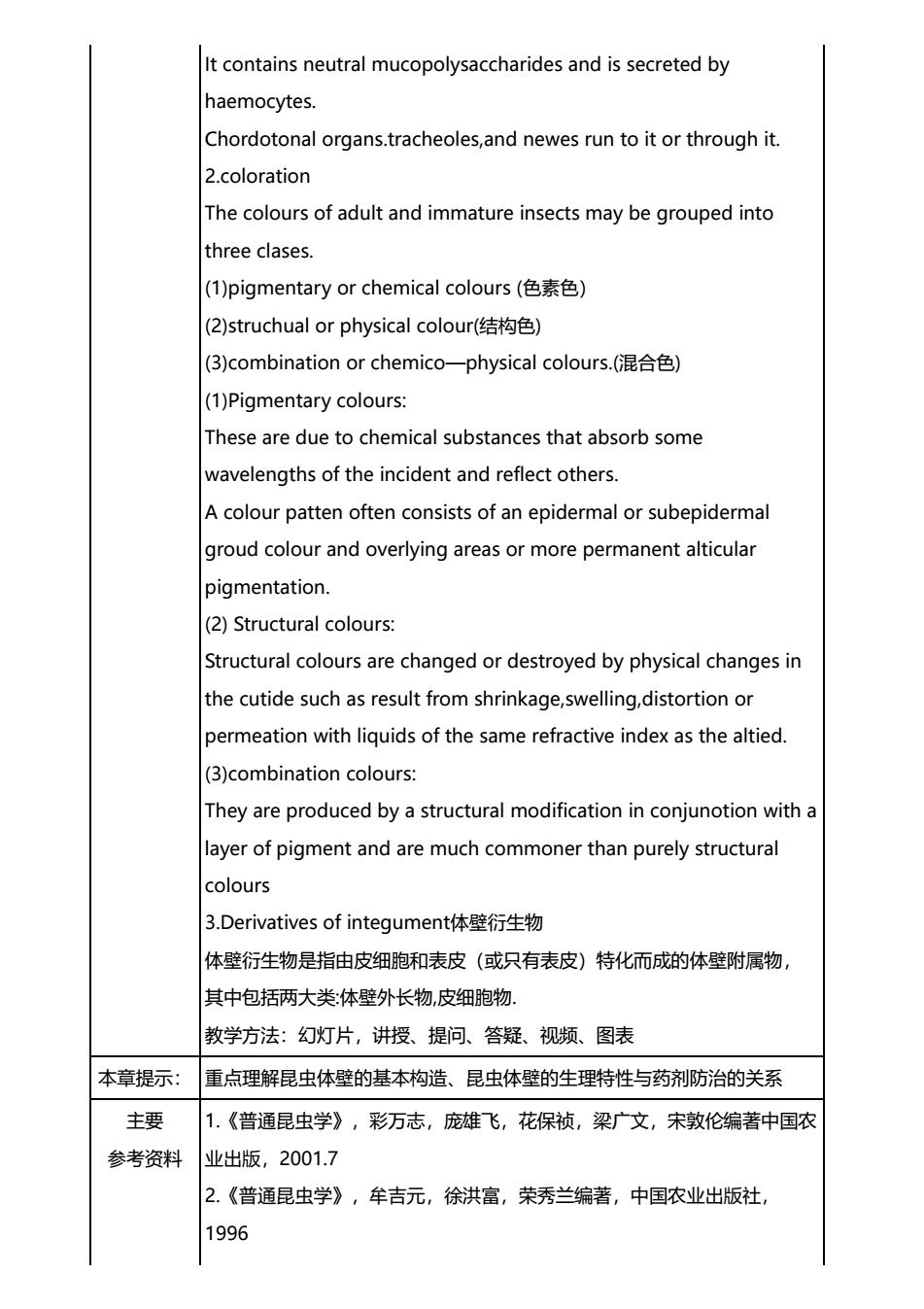
It contains neutral mucopolysaccharides and is secreted by haemocytes. Chordotonal organs.tracheoles,and newes run to it or through it. 2.coloration The colours of adult and immature insects may be grouped into three clases. (1)pigmentary or chemical colours(色素色) (2)struchual or physical colour(结构色) (3)combination or chemico一physical colours.(混合色) (1)Pigmentary colours: These are due to chemical substances that absorb some wavelengths of the incident and reflect others. A colour patten often consists of an epidermal or subepidermal groud colour and overlying areas or more permanent alticular pigmentation. (2)Structural colours: Structural colours are changed or destroyed by physical changes in the cutide such as result from shrinkage,swelling,distortion or permeation with liquids of the same refractive index as the altied. (3)combination colours: They are produced by a structural modification in conjunotion with a layer of pigment and are much commoner than purely structural colours 3.Derivatives of integument体壁衍生物 体壁衍生物是指由皮细胞和表皮(或只有表皮)特化而成的体壁附属物, 其中包括两大类体壁外长物,皮细胞物. 教学方法:幻灯片,讲授、提问、答疑、视频、图表 本章提示: 重点理解昆虫体壁的基本构造、昆虫体壁的生理特性与药剂防治的关系 主要 1.《普通昆虫学》,彩万志,庞雄飞,花保祯,梁广文,宋敦伦编著中国农 参考资料 业出版,2001.7 2.《普通昆虫学》,牟吉元,徐洪富,荣秀兰编著,中国农业出版社, 1996
It contains neutral mucopolysaccharides and is secreted by haemocytes. Chordotonal organs.tracheoles,and newes run to it or through it. 2.coloration The colours of adult and immature insects may be grouped into three clases. (1)pigmentary or chemical colours (色素色) (2)struchual or physical colour(结构色) (3)combination or chemico—physical colours.(混合色) (1)Pigmentary colours: These are due to chemical substances that absorb some wavelengths of the incident and reflect others. A colour patten often consists of an epidermal or subepidermal groud colour and overlying areas or more permanent alticular pigmentation. (2) Structural colours: Structural colours are changed or destroyed by physical changes in the cutide such as result from shrinkage,swelling,distortion or permeation with liquids of the same refractive index as the altied. (3)combination colours: They are produced by a structural modification in conjunotion with a layer of pigment and are much commoner than purely structural colours 3.Derivatives of integument体壁衍生物 体壁衍生物是指由皮细胞和表皮(或只有表皮)特化而成的体壁附属物, 其中包括两大类:体壁外长物,皮细胞物. 教学方法:幻灯片,讲授、提问、答疑、视频、图表 本章提示: 重点理解昆虫体壁的基本构造、昆虫体壁的生理特性与药剂防治的关系 主要 参考资料 1.《普通昆虫学》,彩万志,庞雄飞,花保祯,梁广文,宋敦伦编著中国农 业出版,2001.7 2.《普通昆虫学》,牟吉元,徐洪富,荣秀兰编著,中国农业出版社, 1996